Engineering:Gotha LD 5
From HandWiki
| LD 5 | |
|---|---|

| |
| Role | Military utility aircraft |
| National origin | Germany |
| Manufacturer | Gotha |
| First flight | 1914 |
| Primary user | Luftstreitkräfte |
| Number built | 6 |
The Gotha LD 5 (for Land Doppeldecker - "Land Biplane") was a military aircraft produced in Germany during the early part of World War I.
Development
Developed to the Kavallerie Flugzeug requirement for light fast scouting aircraft, the LD 5 was used for training and reconnaissance, it was a conventional design with two-bay unstaggered wings, tailskid landing gear, and a single open cockpit. Flight tests showed it to be unable to live up to intended reconnaissance duties and so the LD 5 was relegated to being a trainer. The LD 5's short wings also rendered it confined to long runways, but the LD 5 was ordered into modest production despite deficiencies.
Operators
 Germany
Germany
- Luftstreitkrafte
Specifications (LD 5)
Data from [1]
General characteristics
- Crew: 1
- Length: 5.8 m (19 ft 0 in)
- Wingspan: 8.7 m (28 ft 7 in)
- Empty weight: 385 kg (849 lb)
- Powerplant: 1 × Oberursel U.I 9-cylinder air-cooled rotary piston engine, 75 kW (100 hp)
- Propellers: 2-bladed fixed-pitch propeller
Performance
- Maximum speed: 115 km/h (71 mph, 62 kn)
- Cruise speed: 105 km/h (65 mph, 57 kn)
See also
Related development
References
Further reading
- Gray, Peter; Thetford, Owen (1970). German Aircraft of the First World War (2nd ed.). London: Putnam. p. 394. ISBN 0-370-00103-6. https://archive.org/details/germanaircraftfi00thet.
- Herris, Jack (2013). Gotha Aircraft of WWI: A Centennial Perspective on Great War Airplanes. Great War Aviation Centennial Series. 6. Charleston, South Carolina: Aeronaut Books. ISBN 978-1-935881-14-8.
- Metzmacher, Andreas (2021). Gotha Aircraft 1913-1954: From the London Bomber to the Flying Wing Jet Fighter. Brimscombe, Stroud: Fonthill. ISBN 978-1-78155-706-8.
 |


